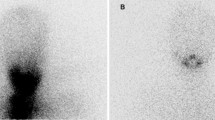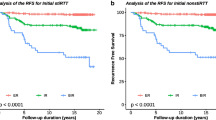Abstract
Objective
To determine which Thyroglobulin (Tg) level after levothyroxine (LT4) withdrawal (stimulated thyroglobulin - sTg) measured before radioiodine therapy (RAIT) is able to predict incomplete response to treatment of differentiated thyroid carcinoma (DTC) with greater sensitivity and specificity one year after initial treatment with I131.
Methods
A chart review was performed in which 375 patients with DTC treated with RAIT were included. The sTg was measured in all patients prior to treatment with I131. Follow up were then performed one year later. Initial sTg levels were associated to DTC outcomes. A receiver operating characteristic (ROC) curve was performed to achieve a sTg level able to predict which patients would have a greater chance of having an incomplete response to RAIT.
Results
Incomplete response to treatment was found in 122 patients (32.5%), this group had a mean sTg of 23.2 ng/mL. ROC curve showed that the optimal cut-off sTg level was 4.4 ng/mL. (sensitivity: 72.1%; specificity: 72.3%; accuracy: 72.2%; positive predictive value of 55.7%; and negative predictive value: 84.3%).
Conclusion
sTg pre-ablation is a valuable predictor of DTC incomplete response to treatment one year after RAIT. Levels of 4.4 ng/ml or more showed higher accuracy to predict this outcome.



Similar content being viewed by others
Data availability
The data sheet is available for consultation.
References
B.R. Haugen, E.K. Alexander, K.C. Bible, G.M. Doherty, Mandel et al. 2015 American Thyroid Association management guidelines for adult patients with thyroid nodules and differentiated thyroid cancer: the American Thyroid Association guidelines task force on thyroid nodules and differentiated thyroid cancer. Thyroid 26, 1–133 (2016). https://doi.org/10.1089/thy.2015.0020
P.W. Rosário, L.S. Ward, G.A. Carvalho, H. Graf, R.M. Maciel, L.M. Maciel, A.L. Maia, M. Vaisman, Nódulo tireoidiano e câncer diferenciado de tireoide: atualização do Consenso Brasileiro. Endocrinol Metab 57, 240–264 (2013). https://doi.org/10.1590/S0004-27302013000400002
F. Pacini, M. Schlumberger, H. Dralle, R. Elisei, J.W. Smit, W. Wiersinga, European consensus for the management of patients with differentiated thyroid carcinoma of the follicular epithelium. Eur J Endocrinol 154, 787–803 (2006). https://doi.org/10.1530/eje.1.0258
R.M. Tuttle, R. Leboeuf, Follow up approaches in thyroid cancer: a risk adapted paradigm. Endocrinol Metab Clin North Am 37, 419–435 (2008). https://doi.org/10.1016/j.ecl.2008.02.008
F. Pacini, Follow-up of differentiated thyroid cancer. Eur J Nucl Med 29, S492–S496 (2002). https://doi.org/10.1007/s00259-002-0847-9
M. Spaas, B. Decallonne, A. Laenen, J. Billen, S. Nuyts, Prognostic value of stimulated thyroglobulin levels at the time of radioiodine administration in differentiated thyroid cancer. European thyroid journal 7, 211–217 (2018). https://doi.org/10.1159/000489849
J. Jayasekara, P. Jonker, J.F. Lin, A.F. Engelsman, M.S. Wong, S. Kruijff et al. Early postoperative stimulated serum thyroglobulin quantifies risk of recurrence in papillary thyroid cancer. Surgery 167, 40–45 (2020). https://doi.org/10.1016/j.durg.2019.06.048
R.C. Webb, R.S. Howard, A. Stojadinovic, D.Y. Gaitonde et al. The utility of serum thyroglobulin measurement at the time of remnant ablation for predicting disease-free status in patients with differentiated thyroid cancer: a meta-analysis involving 3947 patients. J Clin Endocrinol Metab 97, 2754–2763 (2012). https://doi.org/10.1210/jc.2012-1533
R.M. Tuttle, H. Tala, J. Shah et al. Estimating risk of recurrence in differentiated thyroid cancer after total thyroidectomy and radioactive iodine ablation: using response to therapy variables to modify the initial risk estimates predicted by the new American Thyroid Association staging system. Thyroid 20, 1341–1349 (2010). https://doi.org/10.1089/thy.2010.0178
Amin, M.B., Edge, S., Greene, F., Byrd, D.R., Brookland, R.K., Washington, M.K., Gershenwald, J.E., Compton, C.C., Hess, K.R., et al. (Eds.). AJCC Cancer Staging Manual (8th edition). Springer International Publishing: American Joint Commission on Cancer (2017).
M. Melo, G. Costa, C. Ribeiro et al. Stimulated thyroglobulin at recombinant human tsh-aided ablation predicts disease-free status one year later. J Clin Endocrinol Metabol 98, 4364–4372 (2013). https://doi.org/10.1210/jc.2013-2267
J.I. Lee, Y.J. Chung, B.Y. Cho, S. Chong, J.W. Seok, S.J. Park, Postoperative-stimulated serum thyroglobulin measured at the time of 131I ablation is useful for the prediction of disease status in patients with differentiated thyroid carcinoma. Surgery 153, 828–835 (2013). https://doi.org/10.1016/j.surg.2012.12.008
P.W. Rosario, A.C. Xavier, M.R. Calsolari, Value of postoperative thyroglobulin and ultrasonography for the indication of ablation and 131I activity in patients with thyroid cancer and low risk of recurrence. Thyroid 21, 49–53 (2011). https://doi.org/10.1089/thy.2010.0145
F. Pitoia, E. Abelleira, G. Cross, Thyroglobulin levels measured at the time of remnant ablation to predict response to treatment in differentiated thyroid cancer after thyroid hormone withdrawal or recombinant human TSH. Endocrine 55, 200–208 (2017). https://doi.org/10.1007/s12020-016-1104-5
A. Kelly, B. Barres, F. Kwiatkowski et al. Age, thyroglobulin levels and ATA risk stratification predict 10-year survival rate of differentiated thyroid cancer patients. PloS one 14, 8 (2019). https://doi.org/10.1371/journal.pone.0221298
A. Campennì, R.M. Ruggeri, M. Siracusa et al. Early preablation rhTSH-stimulated thyroglobulin predicts outcome of differentiated thyroid cancer (DTC) patients. Eur J Nucl Med Mol Imaging 48, 2466–2475 (2021). https://doi.org/10.1007/s00259-020-05153-7
P.G.C. Trevizam, J.V. Tagliarini, E.C. Castilho et al. Thyroglobulin levels and thyroglobulin/thyrotropin ratio could predict the success of the ablative/therapeutic 131I in the differentiated thyroid cancers. Endocrine Res. 42, 42–48 (2017). https://doi.org/10.3109/07435800.2016.1173056
A. Piccardo, F. Arecco, S. Morbelli, P. Bianchi et al. Low thyroglobulin concentrations after thyroidectomy increase the prognostic value of undetectable thyroglobulin levels on levothyroxine suppressive treatment in low-risk differentiated thyroid cancer. J Endocrinol Invest 33, 83–87 (2010). https://doi.org/10.1007/BF03346558
T.Y. Kim, W.B. Kim, E.S. Kim et al. Serum thyroglobulin levels at the time of 131 I remnant ablation just after thyroidectomy are useful for early prediction of clinical recurrence in low-risk patients with differentiated thyroid carcinoma. J Clin Endocrinol Metab 90, 1440–1445 (2005). https://doi.org/10.1210/jc.2004-1771
F. Pitoia, M.F. Bueno, E. Abellera, M.E. Salvai, L. Bergoglio, M. Luster, H. Niepomniszcze, Undetectable pre-ablation thyroglobulin levels in patients with differentiated thyroid cancer: it is not always what it seems. Arq Bras Endocrinol Metabol 57, 300–306 (2013). https://doi.org/10.1590/S0004-27302013000400004
D. Albano, M. Bonacina, R. Durmo et al. Efficacy of low radioiodine activity versus intermediate-high activity in the ablation of low-risk differentiated thyroid cancer. Endocrine 68, 124–131 (2020). https://doi.org/10.1007/s12020-019-02148-9
Author information
Authors and Affiliations
Corresponding author
Ethics declarations
Conflict of interest
The authors declare no competing interests.
Ethics
This research project was approved by the Ethics Committee of Universidade Federal de Pernambuco – Centro de Ciências da Saúde (2015).
Informed consent
Written consents were obtained from each patient.
Additional information
Publisher’s note Springer Nature remains neutral with regard to jurisdictional claims in published maps and institutional affiliations.
Rights and permissions
About this article
Cite this article
Nóbrega, G., Cavalcanti, M., Leite, V. et al. Value of stimulated pre-ablation thyroglobulin as a prognostic marker in patients with differentiated thyroid carcinoma treated with radioiodine. Endocrine 76, 642–647 (2022). https://doi.org/10.1007/s12020-022-03021-y
Received:
Accepted:
Published:
Issue Date:
DOI: https://doi.org/10.1007/s12020-022-03021-y




